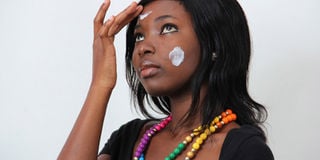How sunscreen became vital

The sunscreen conversation is getting louder owing to skin cancer. It is no longer simply about youth and beauty but a preventative measure against carcinogens. Just because it seems dreary outside does not mean you lay off the SPF. PHOTO/CHARLES KAMAU
What you need to know:
- The impact being we rarely apply as much sunscreen as we should, if at all, on ourselves or our children.
- Regulations in the industry as well as Europe and Australia capped the SPF at 50 because higher numbers make people more careless.
- They stay out longer and do not practise healthy protection habits.
You would think this is an apt conversation for August, hot in more ways than one. Or any of the months inspiring us to famously declare the existence of two suns or the opening to a portal in hell. Months when sunscreen vanishes from shelves because we feel the heat. When cloud cover hits us, bringing with it unexpected rain, it is natural to dismiss the sun. It is a shadow of itself, going on holiday, sipping pina coladas on some other beach.
When did sunscreen become so important? I once read this ghost article - I have never been able to retrieve it off that Google rabbit hole all those years back - that swore sunscreen and toners were the least bought products, inspiring manufacturers and ad agencies to come up with a sexy way to make them part of our beauty arsenal.
Both rocketed their way into our lives but sunscreen has since become legend. Just now I read how we have been applying sunscreen wrong. I avoid my delicate eye area and lips because sunscreen tastes like plastic and burns the eyes with the unapologetic sting of a mild acid. But, it would seem, we need to apply sunscreen on every square inch of our faces. As it is, I am yet to meet anyone who reapplies sunscreen in the course of a normal day in the city.
This SPF rolling stone has done some good for women of colour who had to live with the greyish yellowish coating of sun protection that simply did not infuse into our delicious chocolate tones. With the injection of beauty into skin care absorbable SPF is now the real deal. Still, let us be pragmatic.
More women are using sun protection now because we have been told it is anti aging, prevents wrinkles, hyperpigmentation and sun damage and when used daily, it has literally been declared the fountain of youth. Sun protection, survey says, will also serve the distinct purpose to minimise scarring when applied in the process of healing. There is a three minute video on YouTube titled How the sun sees you. Once you watch it you will become obsessed with protecting your skin.
Kenyans are not swimsuit people. We don’t embrace bikinis, run along the waterfront chasing each other and kids or take part in watersports. Beach vacations consist of dressing down and getting beached on the chaise lounge or next to the bars.
The impact being we rarely apply as much sunscreen as we should, if at all, on ourselves or our children. Regulations in the industry as well as Europe and Australia capped the SPF at 50 because higher numbers make people more careless. They stay out longer and do not practise healthy protection habits. Next time you buy sunscreen make sure it is broad spectrum. This means it protects against both UVB and UVA rays. UVB are the rays that feel hot on and burn your skin. UVA are the rays that you do not feel but they will damage the skin.
You would think a higher SPF offers more protection. Well, to a point.
SPF 15 = 92 per cent UV block
SPF 30 = 96 per cent UV block
SPF 50 = 98 per cent UV block
There was a time it was presumed the SPF and the number of hours one could stay out in the sun before damage starts happening was a precious belief. This has since been rubbished. A higher SPF doth not buy you more hours in the sun.
The sunscreen conversation is getting louder owing to skin cancer. It is no longer simply about youth and beauty but a preventative measure against carcinogens. Just because it seems dreary outside does not mean you lay off the SPF. If there is light, there should be SPF.
It takes anything from 15 minutes to 30 minutes for the skin to absorb sunscreen so don’t just swipe it and run out. Acne prone skin treated with Retin-A, benzoyl peroxide or Accutane will find sunscreen prevents hyperpigmentation and scarring, if you buy a brand compatible with your skin goals. Avoid this list of ingredients: “butyl stearate, cocoa butter, cinnamon oil, Cocos nucifera (coconut oil), decyl oleate, isopropyl isostearate, isopropyl myristate, isopropyl neopentanoate, isopropyl palmitate, myristyl myristate, myristyrl propionate, octyl palmitate, octyl stearate, peppermint oil or propylene glycol-2 (PPG-2).”
Debate as to whether everyone ought to wear sunscreen every single day persists. Rather than pick and choose, I would recommend daily wear. Mainly because life has a tendency to be unpredictable. Look for zinc oxide and titanium dioxide your skin may as well be dressed for it if nothing else.





